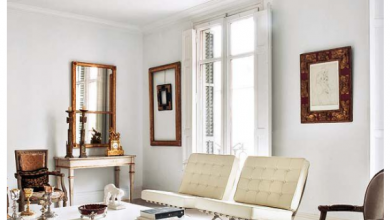How tiles can affect your house atmosphere?

When you’re in the middle of a home renovation project, one of the first things that you’ll think about are the flooring options. What kind of floor would you prefer in specific rooms? There are numerous factors to consider, and one of them tends to stand out—the home’s atmosphere. Whether we’re talking in a literal or figurative sense, it’s important to note that tiles can affect both in different ways. If you’re wondering what kinds of benefits tiles can provide your home and its atmosphere, we’ll go over the major ones below.
Do tiles affect your home’s atmosphere?
You’ve probably noticed that the design of a room can have an enormous impact on how it feels. Everything from the color of the walls to the type of furniture you use sets a specific kind of atmosphere in one way or another. Even small accessories can affect things like mood and coziness, so it should come as no surprise that flooring can do this as well. Though, it has a much higher impact than other elements, considering that it’s one of the largest surfaces in any room.
Tiles are especially impactful in the rooms they’re placed in. When you walk inside a room that has tiles, it’s not something you don’t notice. Tiling has a specific feel and sets the tone for the room in many different ways. Because of this, there are certain rooms that you shouldn’t place them in—though this depends on a few factors.
Tiles set the temperature
If you’ve ever taken a trip to the kitchen or bathroom on a winter night, you’ll know exactly how tiles affect temperature. They tend to absorb all the heat in a room while remaining relatively cool. Even when you crank the heat up, tiles will rarely retain it for long. It’s why so many people look to tiles when it’s time to decorate the home during winter. Keep in mind, however, that different types of tiles will affect heat in different ways.
When it comes to ceramic tiles, they’ll react exactly how you might expect. They’ll stay cool in most situations and endure the heat without taking damage. Stone tiles retain heat a little better, so they aren’t as cold to the touch. At the same time, they are as durable—if not more—than ceramic ones when it comes to high temperatures.
Much like stone, vinyl tiles lean more on the comfortable side. Unlike stone tiles, however, they’re not as resistant to heat damage. When installing them, it’s important to consult the contractors to see which temperatures they can withstand and which ones they can’t. They’re still relatively durable when it comes to physical damage.
Tiles also cool things down
We’ve talked about how various kinds of tiles handle a room’s heat, but it’s worth mentioning that their cooling effect is pretty neat as well. Consider the fact that we use tiles in kitchens and bathrooms primarily, while only occasionally placing them in living rooms and hallways. These are areas that often produce a lot of heat in one way or another.
After a hot shower, you don’t want your bathroom to remain warm for hours on end. You need something to soak up the heat and keep the room at a comfortable temperature. This is where tiles come in. They provide you with arguably the best eco-friendly way to cool down a room, even though the effect isn’t as strong as actual air conditioning. Every little bit of help counts, especially when you want to balance temperatures in different rooms properly.
Not only do they stay cool, but they also help battle damage from moisture. When cooking or using water fixtures, steam and water droplets will find their way into any nook and cranny in a room. Tiles keep the temperature down, making it harder for mold to grab ahold of certain areas. At the same time, they also make the floor and walls much easier to clean. As a result, you rarely have to think about water damage in bathrooms or kitchens.
Tiles are easy to maintain
Compared to most other types of flooring, tiles a pretty simple to take care of. Due to their smooth surfaces and corners, dusting and cleaning are a breeze. Not to mention, materials like ceramic and porcelain are difficult to stain, so you rarely need to bring out the heavy cleaning agents to do some cleaning.
At the same time, tiles tend to be durable. Vinyl and porcelain are especially good for reducing wear and tear. Even if you have multiple children running and around and playing on the surface, you’ll rarely see it scratch or dent. Porcelain is one of the most durable options you can find. Even after years of use, you can be sure that it’ll retain its shape and function without issue.
Tiles can be good for the environment
When talking about a home’s “atmosphere,” it’s important to address it in a literal sense as well. The air quality of your rooms can be affected by the type of material that you introduce. Most materials that are used for tiles are pretty good for the environment and don’t pollute the air around your home.
Ceramic and porcelain tiles are considered eco-friendly choices, as they don’t emit any VOCs after installation. Stone is often just as clean from pollutants, though that depends on the source of the tiles. If you acquire them from a reputable manufacturer, you don’t have to worry about problems after installation.
Vinyl can be tricky in this aspect, as it often emits VOCs after implementation. If you prefer vinyl over other materials, it’s recommended that you air out your home for a few days, after which time the tiles won’t cause issues. Most of the problems come from the adhesives used to connect the tiles, though even this can be mitigated with some pre-planning. Modern adhesive mixes contain a lesser amount or no VOCs at all, making them much better for the environment. Communicate with contractors that install your flooring to make sure that they use these kinds of adhesives for the renovation.
Tiles come in various shapes and sizes
Other than their direct effect via balancing temperatures, tiles also affect our perception of various rooms. Whether the bathroom is cold or hot, you’ll always perceive it as colder when it’s lined with pure white tiles. This is part of the reason so many homeowners choose pretty similar tile store styles for specific rooms.
However, you don’t have to choose typical designs when implementing tiles. One of their greatest benefits is diversity. You can choose from countless different tile shapes, sizes, and colors. When it comes to design choices—the sky’s the limit!
Stone tiles have become especially popular for creating unique kitchen, bathroom, and living room styles. They can be used as floors, borders, walls, or everything in-in-between. People have started to shy away from classic small squares and are now implementing much more complex designs to fit their home’s styles. Attractive porcelain tiles are especially popular, as their shapes and patterns make for gorgeous flooring, though they can be used on walls as well. Combining warm and dynamic colors with stone tiles creates an interesting contrast that can boost a room’s atmosphere in more ways than one.
Tiles are versatile
What if you don’t like the look of typical, everyday tile designs? Well, there are plenty of different options to choose from. If you prefer the look of other kinds of materials—tiles can mimic them just fine!
Let’s say you want to utilize tiles for their great durability or temperature balancing, but don’t want to have the aesthetic of tiles in a particular room. If the room would go better with a wooden floor design, you can always go for a wood-like tile. It’s just as good as the real thing when it comes to looks, but it also provides the floor with extra protection. Whereas a hardwood floor is relatively easy to scratch and stain, a ceramic wood-like floor won’t show any signs of wear and tear any time soon.
This kind of mimicry also works for different kinds of tiles. If you want to create a tile design for your living room, but don’t want it to feel too cold and uninviting, you can always go with a vinyl alternative. Vinyl can imitate plenty of other tile types with ease, though it’s not nearly as durable as ceramic or stone. However, if you don’t need the added durability in a particular room, the vinyl tiles might be a better choice.
Conclusion
While the type of flooring you choose might not seem all that important for your home’s feel and atmosphere, it can have quite the impact. Whether you want to balance the humidity, temperature, or air quality of a room, you have to consider the kind of flooring you want to implement. Tiles play a huge role in this task, which is why they are some of the most popular choices for various rooms. Consider the above pointers and choose your flooring appropriately.





